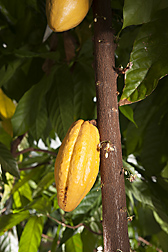This page has been archived and is being provided for reference purposes only. The page is no longer being updated, and therefore, links on the page may be invalid.
| Read the magazine story to find out more. |
|
|
| See our information kit to find out more. |
|
|
Cacao Collection Expedition May Yield Weapons for Combating Witches' Broom Disease
By Sharon DurhamSeptember 15, 2011
Fungi found in the leaves and trunks of wild Peruvian cacao trees offer the potential for biological control of cacao diseases such as witches' broom disease, according to U.S. Department of Agriculture (USDA) scientists. Several of the fungal species were previously unknown to science.
Agricultural Research Service (ARS) researchers at the agency's Sustainable Perennial Crops Laboratory (SPCL) and Systematic Mycology and Microbiology Laboratory (SMML) in Beltsville, Md., and Peruvian collaborators conducted cacao collection expeditions in 2008 and 2009 through the Amazon Basin of Peru. The Peruvian Amazon is the heart of the center of diversity for cacao and holds great potential for finding undiscovered cacao and fungal species.
ARS is USDA's principal intramural scientific research agency, and this research supports the USDA priority of promoting international food security.
During the 2008 collection trip to Peru, SPCL research leader Lyndel Meinhardt recorded the incidence of witches' broom disease in wild cacao trees in the upper Amazon region. The disease can cause yield losses of 75 percent in susceptible varieties. A team of scientists, including SPCL geneticist Dapeng Zhang, SMML mycologist Gary Samuels, Meinhardt and others, found that about 14 percent of flower cushions and 13 percent of trunks of wild cacao plants along the rivers were infected with witches' broom disease. This suggests that there is a high level of witches' broom disease resistance in these wild Peruvian cacao populations.
The fungi found in disease-free leaves and trunks of collected cacao tree tissue samples may provide protection against diseases such as witches' broom disease either by stimulating the immune system of the plants or through direct parasitism or antibiotic effects against pathogens. Samuels found several fungal species previously unknown to science in the cacao tissues. The potential for biological control using these fungi is being evaluated by SPCL scientists Bryan Bailey and Ron Collins.
Meinhardt, Zhang and Samuels collaborated with the Instituto de Cultivos Tropicales (ICT), a research center in Tarapoto, San Martin, Peru, to identify new varieties of cacao. The researchers are studying 342 cacao specimens collected from 12 watersheds and are categorizing the DNA of the specimens.
Read more about this research in the September 2011 issue of Agricultural Research magazine.


